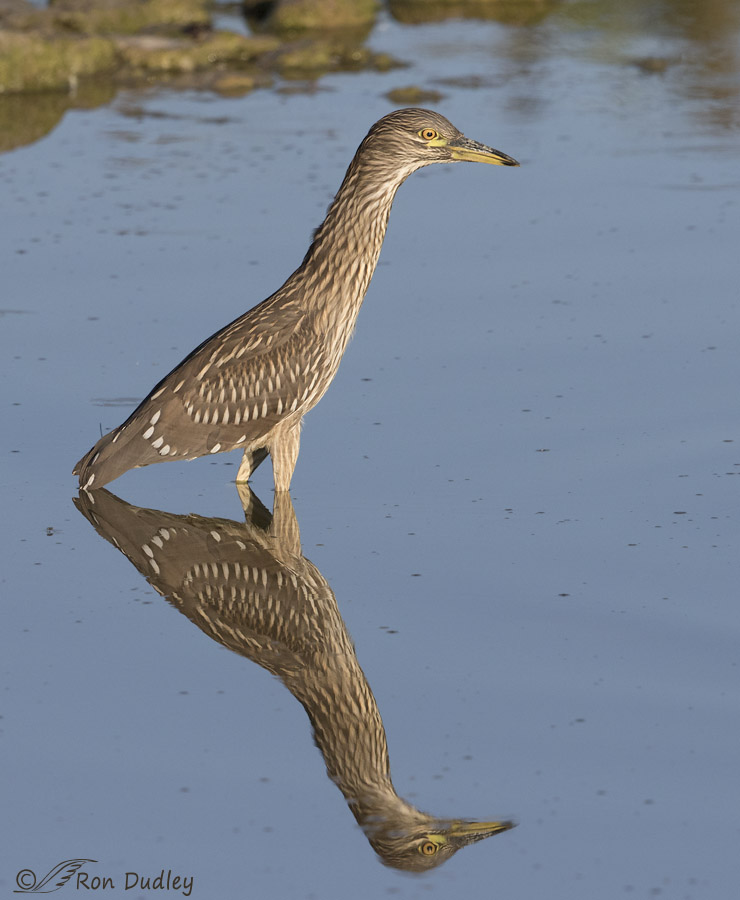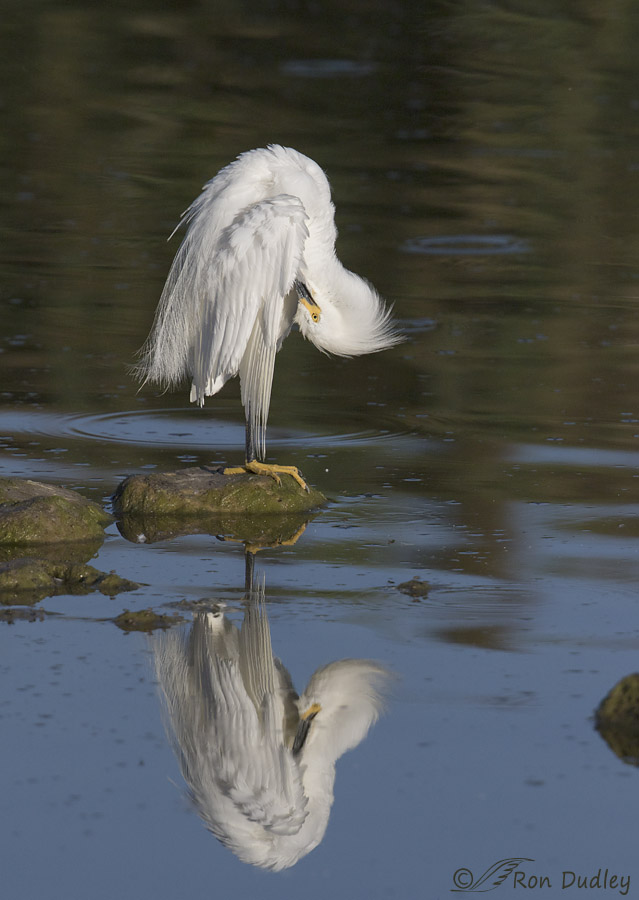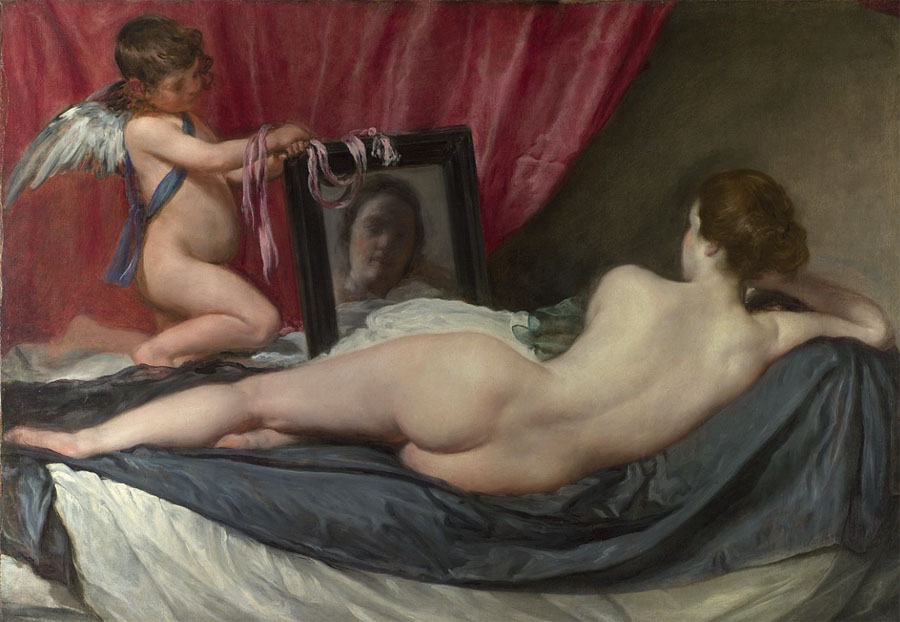Occasionally I rerun a favorite older blog post. Today’s post is a ‘twofer’, containing portions of two different posts originally published in 2015 and 2019. For this version I’ve rewritten much of the text, tweaked the formatting and used a new title.
Many folks believe that when there’s a reflection of a photo subject on the surface of undisturbed water, that reflection is an exact upside-down replica of the way we see the subject itself. Not so. It never is. It can’t be.
In nature photography a reflection typically occurs when light bounces off of an object (a bird for example), strikes the water’s surface and then travels to our eyes. What we see in the reflection is slightly different from what we see in the bird because the angle of light from the reflection to our eyes doesn’t travel the same pathway as that of the light that came directly from the bird to our eyes.
It’s difficult to explain with just words, so I’ll use two of my photos taken at Bear River MBR to demonstrate.

1/5000, f/6.3, ISO 800, Canon 7D Mark II, Canon EF500mm f/4L IS II USM, not baited, set up or called in
At first glance it may appear that the reflection in this photo of an immature Black-crowned Night Heron is an exact upside-down replica of the actual bird and its background. It isn’t. That fact is most easily realized when we notice that there’s a small rock immediately above the head of the heron that is nowhere to be seen in the reflection.
Notice that we also see more of the underside plumage of the heron between the legs and tail in the reflection than we do in the bird itself. There are other more subtle differences too.
Think of it this way – what we’re actually seeing in the reflection is what we would see if our eyeballs were floating somewhere on the surface of the water where the reflection is and looking up at the bird. From that vantage point the rock would not be seen above the head of the bird and we could see more ventral plumage.
 1/3200, f/7.1, ISO 250, Canon 7D Mark II, Canon EF500mm f/4L IS II USM +1.4 tc, not baited, set up or called in
1/3200, f/7.1, ISO 250, Canon 7D Mark II, Canon EF500mm f/4L IS II USM +1.4 tc, not baited, set up or called in
Here’s another example that involves both the bird and the background but I’ll focus on the bird. Notice that in the reflection we see about twice as much of the Snowy Egret’s bill than we do in the bird itself. That’s because the bird is reflected from below (where our imaginary eyeballs are) and at that angle we could see further up into the nooks and crannies of the plumage where the tip of the bill is.
We tend to make assumptions about reflections that aren’t necessarily true, a tendency that some artists deliberately take advantage of in their paintings.

Photo in public domain
This is Velázquez’s Rokeby Venus. In the painting we see the goddess Venus in a sensual pose, lying on a bed and looking into a mirror held by the Roman god of physical love, her son Cupid. There are several other famous paintings similar to this one with Cupid holding a mirror and Venus appearing to look at her own reflection in the mirror.
But as painted, that would be impossible.
Since we the viewers, and presumably Velázquez himself, can see the reflection of Venus’s face in the mirror, it would be impossible for Venus to also see her face in the mirror at the same time. Two viewers in different locations cannot see the same reflection in the same mirror at the same time.
Velázquez of course was perfectly aware of that fact. It’s an artist’s ‘trick’, that has been used often enough by various artists to earn its own name. In art it’s called the “Venus Effect“.
In the hard sciences and in psychology it’s called “naïve physics” – a line of research that focuses on the tendency of most people to hold beliefs that are inconsistent with observable phenomena.
Ron


Ron, you missed your calling as a physics teacher (or a least coordinated/integrated science). I also enjoyed spending some of my planning periods observing other classes — never a waste of time to watch good teaching in action!
I also enjoyed spending some of my planning periods observing other classes — never a waste of time to watch good teaching in action!
What a glorious post, commentary and “critical reviews” from the FP fans — my day is made perfect by knowing I am in good company as one among many “naive physicists”!
Thanks, Chris. “Naive physicists” – I like that.
Very nice photos and explanation. I knew about the Venus Effect in art. In 7Th grade I had a well seasoned art teacher who taught theory along with history of art. He was what I considered the best art teacher I had. Sadly he retired after that year. I had others who were good, they always wanted to be friendly and positive with the students the “art as fun therory” rather than teach us to stretch our skill and thoughts. I think I learned more from that first year than in all the remaining 7 years. I was talented, both I think through genetics and desire, I took all the art classes available none pushed me to excel as he did, I was allowed to coast, wish I was pushed more.
April, I never took a single art class in my 17 years of formal education. I have big regrets about that. The closest I came was a music appreciation class in college (taught by Dave Brubeck’s brother Howard).
To partially make up for it, I often sat in on the classes of Highland High School art teachers Gordon Moore and Pat Eddington during my free periods. Both are excellent teachers so I learned some stuff.
I also sat in on English Literature classes (Sue Southam), chemistry classes (Doug Tate) and, at South High School, home ec classes (Judy McCleery). Judy’s classes inspired my passion for cooking – but even Judy couldn’t get me interested in baking. I still have two of her cookbooks and the marble slab she gave me for rolling out pie dough but I never use it. Lugging that thing around will give you muscles!
Ron, I don’t know if a thank you is warranted for this post! Do you know how much work you have just created for this old brain? Now every reflection has to be analyzed for “where the eyeballs are”! Already, 2 articles with pictures of mirrors – TWICE the “estimated reading time” because the pictures had to be studied, not just skimmed over with a “that’s nice”. Old dog, New tricks – Thaaanks?
Carolyn, reading your comment not only made me smile, it brought an audible chuckle!
So we see Venus and Venus sees us such an interesting post. Looking at the birds it is so obvious but I never would have seen it without you’re pointing it out. Thanks for a nice lesson to start the morning.
such an interesting post. Looking at the birds it is so obvious but I never would have seen it without you’re pointing it out. Thanks for a nice lesson to start the morning.
Glad you enjoyed it, Catherine. Thanks.
Well, that explains why what I see in the mirror is so much better than reality!
Another terrific explanation which blends nature, photography, science and even classic art.
I really love reflection photographs which show more of the scene than we would see if we had framed just the subject. Your Snowy Egret image is a great example.
Once upon a time, I existed in the world of reality. I highly prefer the atmosphere created by “naive physics”.
“Once upon a time, I existed in the world of reality. I highly prefer the atmosphere created by “naive physics””
I know what you mean, Wally. Reality doesn’t give us any wiggle room…
New information for me. Thanks for another interesting lesson.
Thanks, Michael.
Seeing the way you explain things, I think I wish I had had you as a teacher in my high school days.
Very interesting lesson Ron.
Thank you very much.
Thanks for the very kind words, Jorge.
Beautiful pictures and explanation. The “venus effect” is new to me. It will take a while for me to entirely understand it. Ron, a request. I have spent my entire adult life trying to understand why mirrors reflect left and right backwards but not up and down. EVERY day I google this and read the explanation and say aah and then next morning its gone. You are a teacher extraordinaire, could you take a stab at this? You have an eager student but someone apparently with a karst- like mind. (I learned that word 2 days ago and now have to work it into every conversation to show off.)
“why mirrors reflect left and right backwards but not up and down”
Frances, mirrors don’t reflect left to right. Instead, they flip front to back. Here’s a link to the best explanation of the phenomenon I’m aware of (better than I could do) but then you may have already seen it.
https://www.wtamu.edu/~cbaird/sq/2013/01/05/why-do-mirrors-flip-left-to-right-and-not-up-to-down/#:~:text=Mirrors%20do%20not%20flip%20left,equals%20the%20angle%20of%20incidence.
Ron, I had NOT seen this before. Am perusing it now. The idea that the confusion is all due to us turning our heads again is new to me. THANKS.
Great post! It’s always doubly enjoyable when you can learn something at the same time as you experience pleasure from lovely photos. This is the first time I have heard the term “naive physics” but it seems like it might be another example of the same thing many of us have heard about before, usually presented by psychologists? when they talk about how the brain creates or deals with the ever popular optical illusions? Would that be the same idea as what we see here ?
“Would that be the same idea as what we see here ?”
I’m no expert, Granny Pat but I believe they’re different.
Gorgeous reflection – but to get them you have to be there when the water is like a mirror, seldom so in my experience. But I’m not there often enough to have a reasonable chance.
The differences are obvious, as one would expect, but so often we don’t look carefully and miss things.
Another impossible reflection is Manet’s – A Bar at the Folies-Bergere. One of my favourite paintings
A link to “one of your favorite paintings”, David. I see what you mean.
https://en.wikipedia.org/wiki/A_Bar_at_the_Folies-Berg%C3%A8re#/media/File:Edouard_Manet,_A_Bar_at_the_Folies-Berg%C3%A8re.jpg
Thanks ! I love continuing to learn at my advanced age, and Feathered
Photography gives me a good “dose” almost every day .
Me to, Kris – including “at my advanced age”.
Wonderful lesson. We have reflections in our windows from a complex exterior of garden and woods and I can’t for the life of me figure them all out. Fascinating and maddening. I will approach them now from the “eyes” as you have described.
Thank you, Sallie.
Wow – our photography expert, biologist, ans ornithologist, shows us that he is also a knowledgeable fan of art. There is no end to the remarkable skills of our Feathered Photographer.
Thanks Ron – really appreciate this explanation of how we see the reflections. I am a big fan of bird reflection photos and once made myself a photo book of all my best ones. We have five lakes so I get many chances for good reflection photos.
“our photography expert… shows us that he is also a knowledgeable fan of art”
You give me too much credit, Everett. I know far more about how to do internet research than I do about art…
With this most edifying elucidation i now realize that, upon reflection, I have been living under an illusion.
Eyeballs floating on the water. I think I just realized what an outstanding teacher you must have been. And are.
Thanks very much, Lyle. My students were always teenagers so phrases like “eyeballs floating on water” always got their attention and were very effective in making my point. But it works with adults too.
Wow, Ron – I’ll never look at a reflection the same way again!! When did you first learn of the “naïve physics”?!!
“When did you first learn of the “naïve physics”?!!”
Jo Ann, I believe I first learned about it a few years ago when I did research for one of my posts about reflections. Can’t remember which one.
Interesting! Never given it any thought just enjoying the reflections and some of the distortions that come with many of them…… Thx for the lesson “teach”……
Thx for the lesson “teach”…… 
You’re very welcome, Judy.
Duh – like having a mirror under them……. See Hell’s Backbone has been successful with GoFundMe – GREAT news……
See Hell’s Backbone has been successful with GoFundMe – GREAT news…… 
Yeah, they did extremely well with their fundraiser. Looks like they’ll be around for a while.